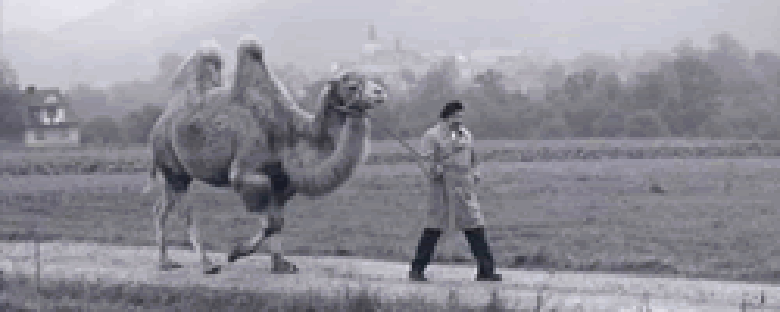Reviews
Duze Zwierze
Jerzy Stuhr
Poland, 2000
Credits
Review by Leo Goldsmith
Posted on 10 July 2004
Source 35mm print, Milestone Films, screened at Anthology Film Archives
Related articles
features: Kieslowski’s Trois Couleurs
reviews: Blind Chance
reviews: Camera Buff
reviews: No End
reviews: The Scar
Since his death in 1996, Krzysztof Kieslowski has been unusually prolific. The late Polish filmmaker has been responsible for the scripts of at least two films, and has undoubtedly more endeavors to come. Although the more prominent of these films was Tom Tykwer’s English language debut, Heaven (part of a once-proposed trilogy), Jerzy Stuhr’s The Big Animal is the first of Kieslowski’s posthumous filmmaking credits.
Lest one accuse Stuhr of an opportunistic digging in the dead man’s papers, it should be noted that The Big Animal’s director and star is a longtime associate of Kieslowski. Stuhr has variously collaborated with the filmmaker since the late 1970’s, when he starred in and co-scripted Camera Buff, one of Kieslowski’s early masterpieces.
The script of The Big Animal apparently dates from this era, and Stuhr’s film closely resembles Kieslowski’s early work. The film may lack the expressionistic lighting, minutely precise close-ups, and structural ambiguity of Kieslowski’s late films, but rather like Camera Buff it explores the moral and civic responsibilities of the individual in a fairly straightforward style.
The film’s titular big animal is, more specifically, a camel (Bactrian, not dromedary), left stranded by a traveling circus in suburban Poland at the outset of the film. Found wandering in the front yard of Zygmunt Sawicki, a schlubby bank clerk (played by Jerzy Stuhr himself), the ruminant becomes the source of much interest, and eventually trouble, for the residents of the small community.
For though the film fully exploits the inherent charm and lovability of Mr. Stuhr and his enormous sidekick (whom he refers to as “buddy”), Kieslowski’s concern for the place of the individual within the community drives the film to richer levels of meaning. As with Filip in Camera Buff, Zygmunt’s private obsession begins to be regarded with suspicion by the larger community. The envious congratulations with which his discovery is first greeted soon dissolve into sidelong glances and nosy questioning. What does Zygmunt intend to do with his camel? He has no answer. Will he not try to use it for capital gain? Most assuredly not.
In this way, the community closes ranks, and Zygmunt, his patient schoolteacher wife, Marysia, and their “buddy” become steadily ostracized. The parents of Marysia’s schoolchildren withdraw their kids from school, and Zygmunt is forced out of the local orchestra (in which he plays second clarinet, which the camel nonetheless enjoys). Zygmunt is repeatedly summoned to the town hall to answer for the camel’s fouling of public streets and to pay his “horse license” (as the tax code has no designation for “camel”).
The Big Animal unfolds rather like a fable of modern life, demonstrating how the small community’s intolerance increases with the fervor of Zygmunt’s unexplained private devotion. The film’s tone deftly shifts from one of sweet comedy to a mysterious melancholy, as the isolation of the Sawickis’ life becomes apparent, and Zygmunt’s quiet, personal desires become the targets of derision and mistrust by his friends and neighbors. To match this shifting mood, the film is shot in equivocal black-and-white (by award-winning cinematographer Pawel Edelman), alternately giving the film the look of ethereality and realism.
At the time that Krzysztof Kieslowski originally wrote this script, he was undoubtedly commenting (as he was in Camera Buff and elsewhere) upon state socialism’s infiltration of the individual’s inner life. In his update of the script, Stuhr finds the same insinuating forces at work in Eastern Europe’s still-incipient capitalism. In this climate, Zygmunt’s fellow citizens find it inexplicable, even unpardonable, that he would not attempt to exploit his camel for profit, while the government remains as inept and bureaucratic as ever. When he finally does relent to the appeals of commerciality (donning a turban to co-star with his camel in a commercial for a flavorless brand of soda), Zygmunt finds the experience painfully humiliating. In this way, the film much resembles Robert Bresson’s Au Hasard, Balthasar in that it invokes the symbolism of man as a beast of burden, to be used and abused according to the world’s whims. Stuhr’s film, however, is far more adorable.
We don’t do comments anymore, but you may contact us here or find us on Twitter or Facebook.



